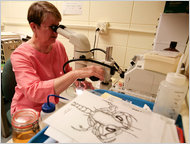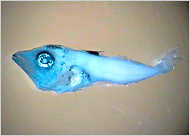
Lee Celano for The New York Times
Harriet M. Perry of the Gulf Coast Research Laboratory in Ocean Springs, Miss., has found oil in larvae samplings, but her testing money has run out.

Lee Celano for The New York Times
The image of a larval blue tuna that scientists tested for evidence of oil from the gulf spill.
In May, Harriet M. Perry, the director of the fisheries program at the Gulf Coast Research Laboratory, was asked to examine some mysterious droplets found on blue crab larvae by scientists at Tulane University. An early test indicated that the droplets were oil, and she has continued to find similar droplets on fresh larvae samples taken all along the northern Gulf of Mexico.
Despite the potential significance of the discovery, Dr. Perry does not have research money to cover further tests. And like other scientists across the Gulf Coast who are racing to sketch out the contours of the BP oil spill’s effects, she has few places to turn for help.
The only federal agency to distribute any significant grant money for oil spill research, the National Science Foundation, is out of money until the next fiscal year begins Oct. 1. The Environmental Protection Agency, which has only $2 million to give out, is still gearing up its program. A $500 million initiative for independent research promised by BP, which was to be awarded by an international panel of scientists, has become mired in a political fight over control. State agencies, too, are stymied.
“We have met with every possible person we can regarding this issue, built the templates, sent in the requests, and we are waiting to see,” said Hank M. Bounds, the Mississippi commissioner of higher education, speaking of the needs of Ms. Perry and other scientists.
There is plenty of science being done on the spill, but most of it is in the service of either the response effort, the federal Natural Damage Resource Assessment that will determine BP’s liability, or BP’s legal defense. Scientists who participate in those efforts may face restrictions on how they can use or publish their data. More important, they do not have a free hand in determining the scope of their studies.
“Independent research is being squeezed by federal agencies on one side and BP on the other,” said Dr. Perry, whose only offer of help has come from BP (she declined). “It’s difficult for the fishing community and the environmentalists to understand why we are not receiving the money that we need.”
Scientists view the situation as urgent because the environmental picture in the gulf region changes daily, as the plume of undersea oil disperses and degrades, fish eggs hatch and crabs molt.
“Time is of the essence,” said Lisa Suatoni, a senior scientist at the Natural Resources Defense Council, an environmental group. “Knowing the answers to basic questions like how much oil is below the surface, where is it going and what is its fate – those are answers that are slipping through our fingers.”
John H. Paul, a biological oceanographer at the University of South Florida, has found evidence of stress and even genetic damage in plankton exposed to the spill. “Everything that I’ve done, I’ve not had funding for,” he said. “I’ve had to pull people off my other projects and say, ‘Here, let’s do this for two weeks.’ ”
Ralph Portier, an environmental scientist at Louisiana State University, said earlier grants would have meant earlier answers to key questions like how long it will take for the oil in the marshes to break down. “We could have had a much better answer to that by now if we had started in the summer,” he said.
But, Dr. Portier said, there was no mechanism set up to provide research money in the event of an oil spill. “We always seem to be reacting and reacting and reacting, rather than being proactive,” he said.
Dr. Suatoni said the federal agencies that scientists normally looked to might not get significant allotments from Congress for spill research. “The government is afraid it’s going to look like we’re asking taxpayers to pay to study a spill that was a result of BP’s actions,” she said.
Right after the spill, gulf research institutions exhausted their budgets, spending hundreds of thousands of dollars to pay for sea voyages and sampling. Scientists used their personal credit cards to begin research projects.
After complaints about the scarcity of research dollars, BP announced that it would spend $500 million over 10 years in a program it called the Gulf Research Initiative. The original structure of the initiative, with an international panel of scientists appointed to review proposals, was applauded by many scientists, who were persuaded that BP genuinely intended to distance itself from the choice of projects and would set no limits on the publication of results.
But gulf scientists and state officials expressed fears that the process would take too long and that the money would go to large, well-financed research institutions outside the gulf region.
So BP wrote checks for $30 million to research centers in the region for “high-priority studies” – $10 million to the Florida Institute of Oceanography, $10 million to the Northern Gulf Institute, and $5 million to the Dauphin Island Sea Lab in Alabama, all university consortiums, and another $5 million to Louisiana State University. Last week, BP announced that $10 million of the initiative money had been awarded to the National Institutes of Health.
The money was in high demand – the Florida Institute of Oceanography, for example, received 233 proposals and gave awards to only 27.
BP promised that guidelines for disbursing the rest of the money were imminent, but politics intervened. Governors of the Gulf States still wanted more local control of the money, and in mid-June the White House backed them up, announcing, “As a part of this initiative, BP will work with governors, and state and local environmental and health authorities to design the long-term monitoring program to assure the environmental and public health of the gulf region.”
A White House spokesman said that statement was never intended to delay the financing process, but the announcement forced BP to rethink its plans and caused anxiety among scientists. Some feared that the delay would extend indefinitely, and that as the spill receded from the public eye, the money would never materialize. Others divined a money grab by governors for their own cash-starved environmental departments. BP has said little, other than that it is following the “White House directive” to consult with the states.
At least three of the governors have signed on to a proposal that a group called the Gulf of Mexico Alliance, a partnership led by state natural resource and environmental agencies, administer the money. Under the plan now being worked out, BP would appoint 10 members of the peer review board and each governor would appoint two members, said William W. Walker, the director of the Mississippi Department of Marine Resources and the co-chairman of the alliance. In Mississippi’s case, he said, there would most likely be one appointee from a state agency and one from a research institution.
But scientists are skeptical of the gulf alliance, in part because it is controlled by agencies rather than universities, and the public silence surrounding the negotiations has raised suspicions.
“It looks like maybe BP caved,” said Gary M. King, a microbial ecologist at Louisiana State University. “There’s no sense of trust that a group of governors are actually going to do the right thing and ensure that there will be good science.”